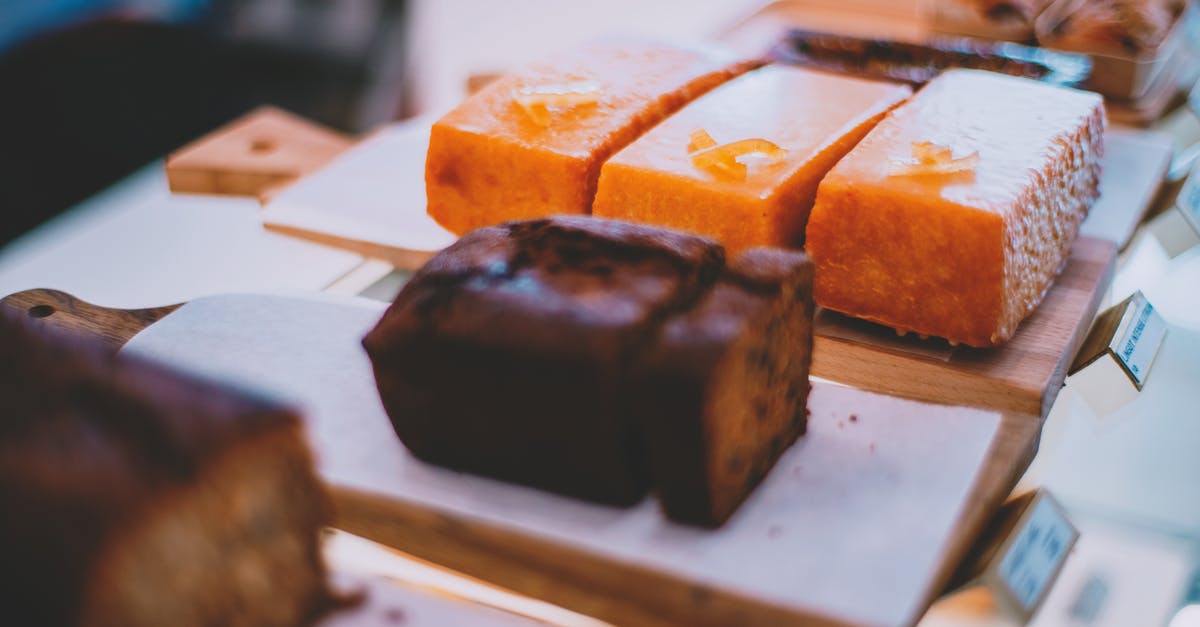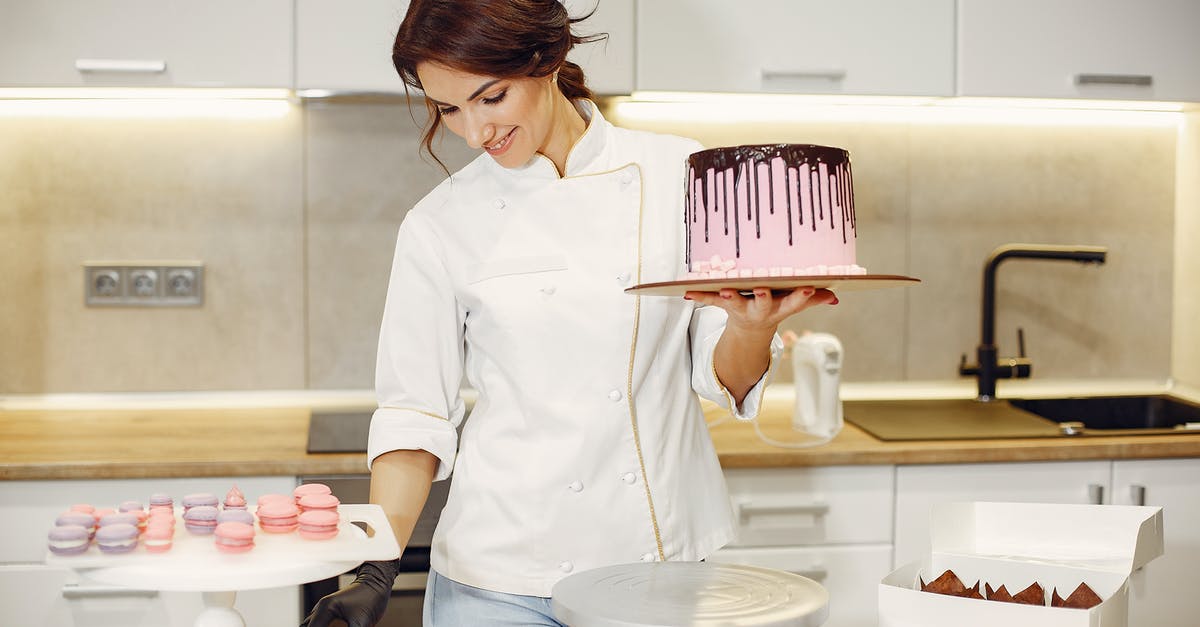Putting a solid chocolate bar inside cake dough: what's the outcome?

Let's say I'm making a plain vanilla cake in a rectangular shape. If I were to put a solid chocolate bar in the middle of the dough before baking it, what would the outcome be when the cake is removed from the oven and has cooled down?
- The bar will have dropped to the bottom and you now have a brown stain on the bottom of the cake
- The bar will remain in place, but after melting it simply becomes solid again so you now have a very hard chocolate bar in the middle of your cake.
- The bar will melt and become chocolate spread inside your cake. After cooling down, it will remain in its semi-liquid state and thus you have a deliciously filled cake.
I'm hoping for outome #3, but I'm pretty sure it won't be that easy. What If I were to put actual chocolate spread inside the cake dough rather than a chocolate bar?
Best Answer
As other answers have said, the result will NOT be (3). The chocolate may melt somewhat during baking, but it will solidify again as it cools. How much it sinks will depend on the thickness of the cake batter -- in some cases it may end up on the bottom, and in other cases it may not sink very much.
To achieve your desired result (a "semi-liquid state"), you should probably begin with a chocolate spread or sauce or whatever that has your desired final consistency. I've seen recipes that use everything from ganache to fudge or even a cream cheese-based chocolate filling. But the majority of recipes out there intend to result in a fairly solid state when cooled.
In any case, by using a thinner spread/sauce, you may be able to get close to your desired result. But you might still encounter some problems:
- The vanilla cake batter must be thick enough so the chocolate layer doesn't spread too much or sink.
- The chocolate spread/sauce might behave erratically when baked, depending on what its ingredients are. It could end up more solid than it initially was after baking (or otherwise change texture), it could partially mix with the surrounding batter (which may or may not produce desirable flavor/texture), it could disrupt baking by producing excess steam or bubbling (perhaps breaking through the surface or producing unstable "bubbles" that could cause the cake to collapse after baking), or it could have other unpredictable effects on the batter immediately surrounding it.
- One option for a thinner spread/sauce, as mentioned in comments, might be to chill it beforehand. This would likely also allow the filling to maintain a better shape rather than spreading unpredictably. On the other hand, it could also cause further baking problems if the batter adjacent to the filling takes too long to bake properly. You could end up with an underdone layer around the filling, or you could dry out the outer layers too much before the interior is done.
- If you do try this, I'd suggest making smaller cakes (individual sized cakes, cupcakes, or perhaps a slightly larger cake with just a few servings). A layer of filling in a large sheet cake is even more likely to disrupt baking and make it difficult to get the sides and center done at the same time. I suppose it might also work in a bundt or ring pan.
In sum, fillings behave unpredictably during baking, and they generally make it much more difficult to achieve uniform doneness. Interior fillings are thus best reserved for situations where the interior layer is intended to have a similar texture and doneness threshold to the cake as a whole.
For these reasons, professional bakers often prefer to fill cakes with soft or "semi-liquid" things after baking. Obviously the simplest and most common solution is a layer cake with a spread in between the layers. If you prefer something more elegant, professional bakers often slice a single layer in half, perhaps cut out some of the interior if desired, and add the filling before reassembling. For smaller (individual-sized) cakes or cupcakes, a syringe can also be used to fill the interior, though how much filling can be inserted will depend on the interior texture of the final cake. These techniques allow you to determine more precisely where the filling ends up and provides a better separation between the filling and the cake textures. If the final cake is to be frosted, it is possible to disguise such things and make the process of filling fairly undetectable in the final product.
That's not to say your desired outcome is impossible to achieve, but it may take some experimentation and the result is likely to be temperamental or inconsistent in baking. I'd personally try to find a reputable recipe to use as a starting point.
By the way, a "molten lava" cake recipe, as suggested by another answer, is also probably not what you're after. Lava cakes are almost always chocolate cakes that are slightly underbaked, so the center does not set completely. How "molten" they remain after cooling varies from recipe to recipe, but they are also usually meant to be served immediately after baking. To achieve your goal, you'd need two cake batters instead of one: a vanilla cake for the exterior and a "molten" chocolate center batter. It's difficult to get the proportions and timing right to succeed with a single "molten" batter; mixing two different batters together while trying to keep one liquid and the other cooked will likely be very difficult. A quick internet search for "lava cakes" uncovered some recipes that claim to do what you want by inserting a piece of ganache or something into the center of a vanilla cake batter, but these recipes mostly seem to rely on being served warm to maintain that gooey center.
Pictures about "Putting a solid chocolate bar inside cake dough: what's the outcome?"



How does chocolate affect baking?
In baking, chocolate provides structure and absorbs moisture. Cakes formulated with chocolate usually need more water and whole eggs than those without cocoa products. It adds texture as well, due to its fat content.Can I add grated chocolate to cake batter?
What is this? To make it you mix the flour with sugar, making a well in the middle, almost like when you make fresh pasta. Add some melted butter, egg yolks and grated chocolate and stir to combine.How do you keep chocolate from melting in a cake?
You can keep melted chocolate from returning to a solid by maintaining it at a temperature between 88 and 90 F, according to Michigan State University. This is too cool for it to burn, but isn't warm enough for it to harden.How do you add chocolate when baking?
To help bring down the temperature of the chocolate, add in the solid chocolate you set aside in step 2 to the bowl of melted chocolate. 6. Stir with a rubber spatula until the chocolate is smooth and reaches a temperature of 89-90 degrees fahrenheit for dark chocolate and 86-88 degrees fahrenheit for milk chocolate.HOMEMADE CHOCOLATE BAR RECIPE l WITH BUTTER l WITHOUT COCONUT OIL or COCOA BUTTER
More answers regarding putting a solid chocolate bar inside cake dough: what's the outcome?
Answer 2
Sorry, but it certainly won't be Nr 3. It may be edible, but I don't see why you'll do that instead of making a delicious chocolate cake instead.
I have dabbled in high-chocolate recipes, and one of them was for chocolate muffins filled with chopped chocolate (not chocolate chips, but a chopped bar) and glazed with chocolate. The pieces of chocolate were edible, but they weren't semiliquid, and they more or less kept their original shape. They certainly didn't magically mix themselves with the remaining batter. I can't say if there was some mixing happening in the liminal area, because the batter was so chocolatey already.
I'd say they were somewhat softer than a complete chocolate bar, they certainly didn't snap under the teeth. But note that I was working with high quality 75% or higher chocolate, not Hershey's or Milka style chocolate, and certainly not baking "chocolate" full of non-cocoa fats. This kind of chocolate is rather soft already as a bar.
If you really want a chocolate cake, as always, don't try to make a recipe, because making a good recipe is hard. There are tons of good recipes, and the best ones are indeed made with a chocolate bar and not cocoa powder. They will direct you to melt the chocolate first and mix it with the batter - exactly the thing which you hoped will happen by itself in your version 3. You have to be careful with the temperature of course, as always when working with chocolate. But the result is worth it.
Answer 3
The only way I get my chocolate chips to stay mostly liquid state is to wrap it within minutes of it coming out of the oven. Which I've read it also a big no no for bacteria I guess. I wrap it tightly twice and stick in a zip type bag.
Answer 4
You can achieve no. 3 Just make sure your is not that runny And mix your chopped up chocolate with a little bit of flour as this will prevent the chocolate from dropping to the bottom Then Pour half of your in the pan Then put in the chopped chocolate cover in flour Then pour the remaining batter And bake
Answer 5
Again...make sure the cake batter is not runny (not talking about chocolate here)....chop the chocolate bar into pieces and mix it with flour (the flour will help not let the chocolate pieces not fall to the bottom of the cake)....then when it's time to prepare the pan....pour half of the cake batter then add the chopped chocolate pieces mix with flour and pour in the remaining batter.... The chocolate doesn't become solid again after melting....either it melts completely or it doesnt...just make sure you chop the chocolate very finely....and enjoy
Answer 6
To give you an idea that putting solid chocolate in the batter works https://youtu.be/uJFSnCukXJY
Sources: Stack Exchange - This article follows the attribution requirements of Stack Exchange and is licensed under CC BY-SA 3.0.
Images: Maria Orlova, Katerina Holmes, Ofir Eliav, Gustavo Fring
